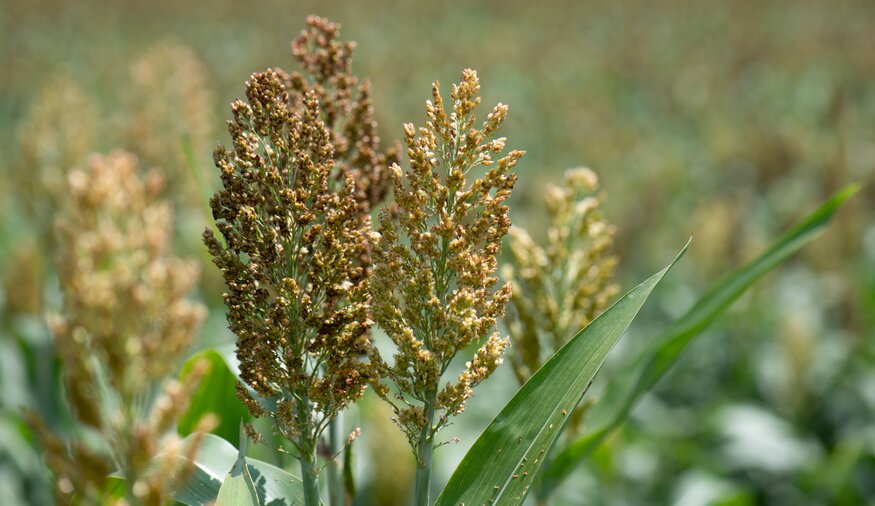Crop Trust Signs Landmark Agreement With Kenya’s National Genebank
 Sorghum near Kakemega County, Kenya. Photo: Michael Major/Crop Trust
Sorghum near Kakemega County, Kenya. Photo: Michael Major/Crop Trust15 June 2021
As part of its Seeds for Resilience Project, the Crop Trust has signed the first of five major agreements with national genebanks in sub-Saharan Africa with the Kenya Agricultural and Livestock Research Organization (KALRO), which is the umbrella body that houses the the Genetic Resources Research Institute (GeRRI) in Kenya.
Seeds for Resilience will provide financial and technical support to help GeRRI meet international standards for seed conservation and data management. Alongside equipment upgrades and technical training, the project will support the genebank in implementing a new quality management system. An outreach component will help the genebank to work more closely with farmers and plant breeders.
“For a long time, we’ve had a dream as a genebank to play a larger role in conserving plant diversity and making it more available. To do that, we must meet certain international standards,” says Joseph Ndungo Kimani, who manages the Information and Management Unit at GeRRI. “This project will enable that dream to come true.”
“This is a milestone for the Crop Trust,” says Nora Castañeda-Alvarez, Seeds for Resilience Project Manager at the Crop Trust. “It’s the first time we are providing such comprehensive, multi-year support to national genebanks.”
Funded by the German Federal Government’s Federal Ministry for Economic Cooperation and Development (BMZ), through the German Development Bank (KfW), the 5-year Seeds for Resilience Project aims to support some of Africa’s most important national genebanks.
National genebanks play a critical role in supporting local farmers and increasing the resilience of food systems, particularly in the context of climate change and other threats to food security.
“GeRRI holds a large and diverse collection of seeds for crops that are vital to national and regional food security, such as sorghum and finger millet,” says Desterio Nyamongo, Director of GeRRI, who is managing the project for the genebank. “This diversity, which is made available under the terms of the International Treaty on Plant Genetic Resources for Food and Agriculture, must be maintained and made broadly available to breeders, researchers and farmers to ensure that crop production can continue under climate change conditions.”
Safeguarding a Treasure Trove of Kenyan Seeds
GeRRI has been conserving seeds since 1988, when it was known as the National Genebank of Kenya. The institute currently holds over 50,000 samples representing over 2,000 plant species, acquired through donations and field collections carried out all over Kenya. So far, around half of these samples have been assessed for their diversity and viability—how many seeds in each sample are alive and able to produce plants.
As with many other genebanks around the world, GeRRI has been facing the challenges of inconsistent funding and insufficient staff.
“It’s unfortunate that GeRRI has significant backlogs of work, including seed viability testing and regeneration. We need to clear them to ensure our collection can be used far into the future,” says Peterson Wambugu, senior research scientist, who is responsible for managing regeneration activities and coordinating the project at the genebank.
The seeds stored at GeRRI range in age from 11 to over 30 years, and there is concern that some samples may be losing viability. The Seeds for Resilience Project will help GeRRI address such challenges, supporting the genebank to document, evaluate and update its crop diversity collection.
Under an early stage of the project, the genebank began implementing GRIN-Global, a comprehensive information management system that allows genebanks to manage data about everything from the genetic diversity of samples to seed health—and share relevant information globally.
“We are streamlining and standardizing the whole process of managing our information, which is a huge leap forward,” Kimani says. “Ultimately, the new system will help us conserve the collection better, and make its diversity more easily available to those who need it.”
Involving Farmers from the Ground up
The Seeds for Resilience Project also aims to strengthen ties between the genebank and the users of the plant genetic diversity it holds: researchers, plant breeders and farmers.
GeRRI’s outreach efforts will be focused on Western Kenya, a region with high levels of food insecurity that has been facing frequent droughts because of climate change. The genebank plans to undertake collaborative research with farmers and plant breeders to identify the best crop varieties for farmers in this region to grow under increasingly harsh climate conditions.
For instance, local farmers will be closely involved in the evaluation of both traditional heirloom varieties held by GeRRI and new improved seeds.
Strengthening Food Security across Sub-Saharan Africa
Across sub-Saharan Africa, farmers are facing the intersecting challenges of climate change, population growth, and food insecurity.
Seeds for Resilience aims to strengthen food security across the continent; and four more agreements are expected to be signed with national genebanks in Nigeria, Zambia, Ethiopia, and Ghana.
“We’ve been collaborating with these five genebanks since 2019 on earlier stages of this project,” says Castañeda-Alvarez. “And their commitment has been amazing, particularly in light of all the challenges related to COVID-19.”
“Seeds for Resilience was designed to ensure that the crop diversity managed in these genebanks is not only safe and available into the future, but shared with farmers and breeders in their respective countries and put to good use,” shares Stefan Schmitz, Executive Director of the Crop Trust.
“With its multi-faceted approach, this agreement could provide a blueprint for the Crop Trust to extend our support to regional and national genebanks, which is so important to the global system of crop diversity conservation,” says Schmitz.
Categories: Data & Information Systems, Seeds for Resilience
